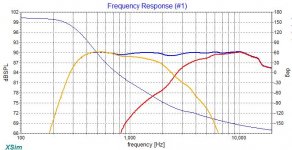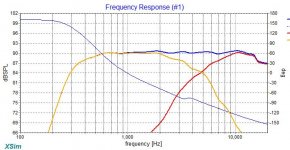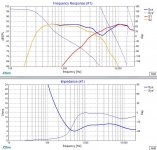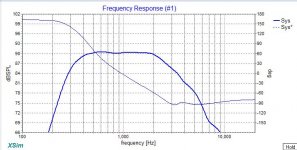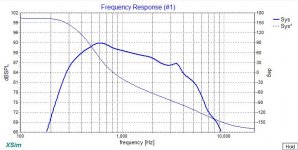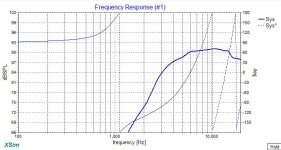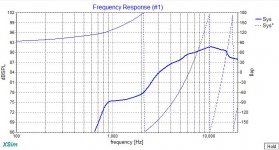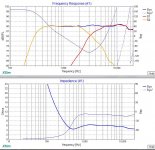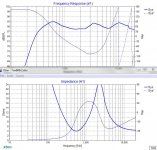Art,
I only use DSP for my subwoofer, and my speakers are quite flat at my listening location without, but still I wonder what it would be like if I attempted to mimic the B&W curves.
The results will depend on the speakers you're using.
My point is / was, that you could recreate that on-axis curve using dsp eq on 10 different speakers and you'll still end up with 10 different sounding speakers, unless of course your listening room is infinitely large or anechoic.
But even if we all listened in anechoic rooms, and used B&W 800 Diamonds, why would we choose to listen dead on-axis at tweeter height where the response is uneven, instead of listening slightly off axis where the response is much flatter?
It's a rhetorical question of course.
I should add, I'm not disagreeing that there aren't technical issue with the design, and particularly the crossover, which I've felt obliged to work on, but I don't think that the Stereophile on-axis measurement is very meaningful in isolation. You need to examine the full suite of measurements, which shows that the speaker has a dip in power through the presence region, in contradiction with the on-axis response. This means that the speaker will sound very different in rooms of different sizes and acoustic properties.
Is their preferred listening location documented anywhere at all? Or is this just something others had to discover by themselves?
Best,
Erik
Best,
Erik
Also Art, I don't share your view as to power response being the uber meaningful thing. I get what it is, and I appreciate it, but I don't think re-creating another speaker's mishapen FR would tell us nothing either.
You may disagree, of course.
Erik
You may disagree, of course.
Erik
Is their preferred listening location documented anywhere at all? Or is this just something others had to discover by themselves?
Best,
Erik
Unfortunately, there's scant little in the documentation.
I raised this issue with the local dealer and discovered that he shared my dissatisfaction and had also raised it with the importer.
Off the record, B&W were aware that speaker position and listening axis and height was highly critical to a good end result, but they felt that it might have had a negative impact on sales if they specifically highlighted the fact in the official documentation.
Instead, they chose to leave it to the dealers to provide installation guidelines.
Speakers that require a head in the vice listening aren't exactly popular from the point of view of being well designed or desirable.
In DIY circles this is true but it is also an opinion that is generally shared with the audiophile market. Head in vice is generally accepted for things like electrostatics but not for cones and domes. It is no wonder that B&W don't speak much of their speakers off axis response because basically it sucks.
One would have thought that B&W would have tried a more typical 4th order at 2kHz approach and literally with it improve every single technical aspect of the loudspeaker. But I wouldn't be surprised if that wasn't the case as none of that would fit in with their overall marketing and design ethos.
In DIY circles this is true but it is also an opinion that is generally shared with the audiophile market. Head in vice is generally accepted for things like electrostatics but not for cones and domes. It is no wonder that B&W don't speak much of their speakers off axis response because basically it sucks.
One would have thought that B&W would have tried a more typical 4th order at 2kHz approach and literally with it improve every single technical aspect of the loudspeaker. But I wouldn't be surprised if that wasn't the case as none of that would fit in with their overall marketing and design ethos.
5th, they worked VERY hard to keep the signature the same. Whatever their reasons, they are sticking to their guns deliberately.
I really really hate this though. B&W was THE reference speaker when I was a kid. I want to totally love them and break up with my next 3 girlfriends because I have a pair taking up too much space. I totally can't, so I share everyone's frustration.
I really really hate this though. B&W was THE reference speaker when I was a kid. I want to totally love them and break up with my next 3 girlfriends because I have a pair taking up too much space. I totally can't, so I share everyone's frustration.
It completely puzzles me though because B&W is a company that is steeped in technical know-how and engineering excellence.
Their cabinets are excellent and follow a very genuine form follows function ethos, without any compromises made towards beautifying their boxes. Their drivers too are excellent, especially in the new series with the inclusion of shorting rings in their bass units. Previously the bass drivers omitted these and probably for cost reasons (B&Ws have traditionally been very reasonably priced for what they are) but they showed the rising third order that you'd typically see as a result (I've seen some third party measurements). This wasn't such a glaring problem as the xover point was quite low, before the rise became a huge issue, but it's nice to see they've added them.
Third party measurements show the FST to be one of the best midrange drivers in the world and from what I've seen the diamond dome tweeter is built like a beast. Not to mention the primary dome resonance coming in at around 100kHz, pretty much the perfect frequency for keeping up to the fifth harmonic free from distortion amplification within the audible band.
There's a tremendous amount of technological and engineering YES boxes ticked in the 800 series top models. Very low diffraction cabinets, pretty much completely inert cabinetry, and drivers with exceptional performance over the frequency ranges that they should be used. What's wrong with the 800 series? The Crossovers are a disaster. Simplistic audiophoolery that pander to the - keep it out of the ears most sensitive band - crowd, with excessive emphasis placed upon using hardly any crossover components (because this is a very good thing 😱) of boutique (and therefore marketable) quality. What B&W don't mention is that in keeping the xover above the ears most sensitive band is that this actually creates more issues within that band than have would been there had it been crossed in.
Shallow slopes used during regions of cone breakup, beaming and excessive C2C distances does not a smooth crossover make. Regardless of if the intended xover frequency is 4-5kHz the slopes fold back rather significantly into the 1-3kHz range and also create an off axis nightmare.
This is not good loudspeaker design.
I do find this confusing and more than a little frustrating. Why bother going to all that effort elsewhere only to then ruin it all with a whack-job of a crossover? As has been mentioned before because they appear to want to make speakers that sound a certain way. It would be nice however if they'd admit this rather than continuing to flout the - recording studio standard - type neutrality and sonic excellence rubbish, which their loudspeakers certainly are not.
It's no surprise that Laurence Dickie left B&W when you see how he designs his Vivid Audio loudspeakers. Lots of influence from B&W can be seen in Vivid's cabinets and drivers (the original nautilus anyone?) but his design ethos and strategies are clearly at a tangent to how B&W now do things. It wouldn't surprise me if he left in frustration rather than anything else.
B&W was THE reference speaker when I was a kid too with the famed Nautilus seemingly mentioned only in passing to elucidate a particular point about another design under review. I too wish they would change their ways and be what it seems both of us (and many others) would like them to be but I cannot see that happening soon. When the D3 was released I was hopeful but essentially nothing (significant) changed. The continuum cone does look to be an improvement over the FST, so at least they are attempting to polish the turd, but unless the crossovers change the same flaws will always be present.
Compromises are always the name of the game when it comes to loudspeaker design and often a designer chooses to compromise on something for the sake of improving something else. All B&W do is crossover high and simple, which is a giant compromise, and all for the benefit of nothing.
Choosing to cross low would be a good compromise (as the tweeter probably shows less linearity down there when driven really hard) because it would then solve all the on and off axis issues.
Of course it goes without saying that although this comes across as being harsh the speakers can probably be made to sound half decent given the right room and positioning. But when one designs such a statement product, with such highfalutin claims, being highly critical only seems appropriate.
Personally I like speakers that work well from any number of listening positions, sitting heights and room acoustics.
Their cabinets are excellent and follow a very genuine form follows function ethos, without any compromises made towards beautifying their boxes. Their drivers too are excellent, especially in the new series with the inclusion of shorting rings in their bass units. Previously the bass drivers omitted these and probably for cost reasons (B&Ws have traditionally been very reasonably priced for what they are) but they showed the rising third order that you'd typically see as a result (I've seen some third party measurements). This wasn't such a glaring problem as the xover point was quite low, before the rise became a huge issue, but it's nice to see they've added them.
Third party measurements show the FST to be one of the best midrange drivers in the world and from what I've seen the diamond dome tweeter is built like a beast. Not to mention the primary dome resonance coming in at around 100kHz, pretty much the perfect frequency for keeping up to the fifth harmonic free from distortion amplification within the audible band.
There's a tremendous amount of technological and engineering YES boxes ticked in the 800 series top models. Very low diffraction cabinets, pretty much completely inert cabinetry, and drivers with exceptional performance over the frequency ranges that they should be used. What's wrong with the 800 series? The Crossovers are a disaster. Simplistic audiophoolery that pander to the - keep it out of the ears most sensitive band - crowd, with excessive emphasis placed upon using hardly any crossover components (because this is a very good thing 😱) of boutique (and therefore marketable) quality. What B&W don't mention is that in keeping the xover above the ears most sensitive band is that this actually creates more issues within that band than have would been there had it been crossed in.
Shallow slopes used during regions of cone breakup, beaming and excessive C2C distances does not a smooth crossover make. Regardless of if the intended xover frequency is 4-5kHz the slopes fold back rather significantly into the 1-3kHz range and also create an off axis nightmare.
This is not good loudspeaker design.
I do find this confusing and more than a little frustrating. Why bother going to all that effort elsewhere only to then ruin it all with a whack-job of a crossover? As has been mentioned before because they appear to want to make speakers that sound a certain way. It would be nice however if they'd admit this rather than continuing to flout the - recording studio standard - type neutrality and sonic excellence rubbish, which their loudspeakers certainly are not.
It's no surprise that Laurence Dickie left B&W when you see how he designs his Vivid Audio loudspeakers. Lots of influence from B&W can be seen in Vivid's cabinets and drivers (the original nautilus anyone?) but his design ethos and strategies are clearly at a tangent to how B&W now do things. It wouldn't surprise me if he left in frustration rather than anything else.
B&W was THE reference speaker when I was a kid too with the famed Nautilus seemingly mentioned only in passing to elucidate a particular point about another design under review. I too wish they would change their ways and be what it seems both of us (and many others) would like them to be but I cannot see that happening soon. When the D3 was released I was hopeful but essentially nothing (significant) changed. The continuum cone does look to be an improvement over the FST, so at least they are attempting to polish the turd, but unless the crossovers change the same flaws will always be present.
Compromises are always the name of the game when it comes to loudspeaker design and often a designer chooses to compromise on something for the sake of improving something else. All B&W do is crossover high and simple, which is a giant compromise, and all for the benefit of nothing.
Choosing to cross low would be a good compromise (as the tweeter probably shows less linearity down there when driven really hard) because it would then solve all the on and off axis issues.
Of course it goes without saying that although this comes across as being harsh the speakers can probably be made to sound half decent given the right room and positioning. But when one designs such a statement product, with such highfalutin claims, being highly critical only seems appropriate.
Personally I like speakers that work well from any number of listening positions, sitting heights and room acoustics.
I know a former B&W engineer, and he once told me that the first nautilus bas units did not have shorting rings, because there test-group, that did listening tests, found the bas was better without shorting rings. It was certainly not a cost concern.
Compromises are always the name of the game when it comes to loudspeaker design and often a designer chooses to compromise on something for the sake of improving something else. All B&W do is crossover high and simple, which is a giant compromise, and all for the benefit of nothing.
Choosing to cross low would be a good compromise (as the tweeter probably shows less linearity down there when driven really hard) because it would then solve all the on and off axis issues.
Crossing over 'low' makes it more difficult to avoid or control diffraction, but if you run the sims, the diamond dome's natural response and sensitivity also invokes an early roll-off when crossed low, so perhaps the reasons are as simple as that.
Running simulations using fully optimised values for 2.5 and 5kHz you can see that the marketing dept would complain about the upper -3dB point coming in well below 20kHz. (see attached, 1&2)
The tweeter that was used in the Nautilus series had a more linear response above 5kHz, and didn't shelve down above 15kHz.
As I've stated previously several times, power response through the presence region would be dramatically better if the tweeter was inverted and time aligned.
In simulations, when I move the fst forward by 1 inch to simulate below axis listening it's plain to see. (see attached, 3&4)
Attachments
Last edited:
For those interested, I've attached the response simulations of the FST and tweeter with filter networks in standard form and modded form.
I've been using the latter for some time now.
I've been using the latter for some time now.
Attachments
And here's the summed response on axis and midway between tweeter and fst height, vs the response before modifications.
You'll also note that my modded crossover now includes conjugate matching to create a more amplifier friendly impedance.
You'll also note that my modded crossover now includes conjugate matching to create a more amplifier friendly impedance.
Attachments
Last edited:
Hylle,
Something was wacked. 🙂 I heard it. i twas the most undwerwheling speaker. Nothing "wrong" really, but lacked dynamic contrast and imaging. Despite the kilowatts of amplifier power on both sides of the preamp, I could not have been moved to spend any money.
I think perhaps their listening sessions were with a speaker already severely underwhelming, and they were choosing among minor variations of underwhelming.
Best,
Erik
Something was wacked. 🙂 I heard it. i twas the most undwerwheling speaker. Nothing "wrong" really, but lacked dynamic contrast and imaging. Despite the kilowatts of amplifier power on both sides of the preamp, I could not have been moved to spend any money.
I think perhaps their listening sessions were with a speaker already severely underwhelming, and they were choosing among minor variations of underwhelming.
Best,
Erik
I agree, one of my friends bought the first nautilus 803, It certainly sounded like 3 nice drivers, but not playing together, for many years now, he uses one of my older stand speakers, and he is much happyer with them...
I know a former B&W engineer, and he once told me that the first nautilus bas units did not have shorting rings, because there test-group, that did listening tests, found the bas was better without shorting rings. It was certainly not a cost concern.
Bass with lots of distortion sounds louder than without. KEF and Tannoy are the great UK loudspeaker manufacturers to my ears.
Plasnu, you should have told me, I would have sent you my files! I just sccanned the Stereophile graphs.
Anyway, please please please tell me what you found! 🙂 I was going to try that wiht my MiniDSP but real life keeps getting in the way.
Seriously, man, tell me!
I'm actually thinking of doing that for a listening party next month, as part of a larger wine, listening thing.
Erik
Hi Erik, I strongly suggest to do it yourself. The test made me understand why many commercial speakers have non-flat response. I guess they do it intentionally for 2 reasons, voicing and hiding the crossover coloration. Mimicking a speaker's FR doesn't make it sound exactly like the other, though, but +-1dB around 1k-4k makes a big difference as you have already known.
But how can you simultaneously also mimic the off-axis response?
Fwiw, I also own a mini dsp, + Dirac live correction, and I've generated correction profiles for on-axis as well as various degrees of off-axis conditions, but I've now arrived where I started, dsp-free and with a very flat response in the listening chair.
No, on axis response only. Off axis response should be flat as possible anyway.
The flat response at the listening chair is not the right way to do correction, as many people had suggested already.
I just browsed through some images of B&W and it is difficult to find models without fundamental flaws on first sight. Or, let´s say, designs which correlate with my understanding of what potentially could be a good speaker.
Take the Nautulus. Would B&W never have heard of Olson´s work on diffraction?
https://www.google.nl/search?q=olso...wiOXOAhUrLcAKHajNBCUQsAQIMg&biw=1647&bih=1135
Just one of those B&W boxes with in-your-face flaws. And the flagship model too.
Take the Nautulus. Would B&W never have heard of Olson´s work on diffraction?
https://www.google.nl/search?q=olso...wiOXOAhUrLcAKHajNBCUQsAQIMg&biw=1647&bih=1135
Just one of those B&W boxes with in-your-face flaws. And the flagship model too.
"Differentiation" may be the big thing. It's like having the Harley Davidson sound.
B&W has staked their reputation on being the reference monitors, yet, if they were neutral they might actually start to sound like other speakers. Not exactly a catch-22, but I am sure their choices aren't financially stupid. Same goes for others who are immitating their FR.
Like it or not, FR matters, and may matter most. It's not the only thing, but for me at least it's the first thing I hear. If I can get past that with a speaker, then I'll try to enjoy it's finer qualities.
Best,
Erik
B&W has staked their reputation on being the reference monitors, yet, if they were neutral they might actually start to sound like other speakers. Not exactly a catch-22, but I am sure their choices aren't financially stupid. Same goes for others who are immitating their FR.
Like it or not, FR matters, and may matter most. It's not the only thing, but for me at least it's the first thing I hear. If I can get past that with a speaker, then I'll try to enjoy it's finer qualities.
Best,
Erik
I know a former B&W engineer, and he once told me that the first nautilus bas units did not have shorting rings, because there test-group, that did listening tests, found the bas was better without shorting rings. It was certainly not a cost concern.
Totally quote you. The first nautilus series were created with final sound in mind. Latest series with sales and marketing hypes and it shows on the actual final sound! Too bad!! I wonder what have been like if they would have actually improved significantly their signature series, which up till date, still easily competes with the best speakers out there.
No, on axis response only. Off axis response should be flat as possible anyway.
The flat response at the listening chair is not the right way to do correction, as many people had suggested already.
Actually, not many people have suggested that.
The importance of off-axis response is beyond doubt but is also very room specific. The response as heard in the listening chair is definitely the most important metric for perceived tonal balance, but is not necessarily closely correlated with a near-field measurement that you might see in Stereophile or Hi-fi News.
It's worth noting the enormous difference between the Stereophile and Hi-Fi news measured response of the 802D2 and D3.
Which begs the question, are both flawed, and if not which is correct?
- Home
- Loudspeakers
- Multi-Way
- B&W Signature 800 upgrade diamond tweeter
